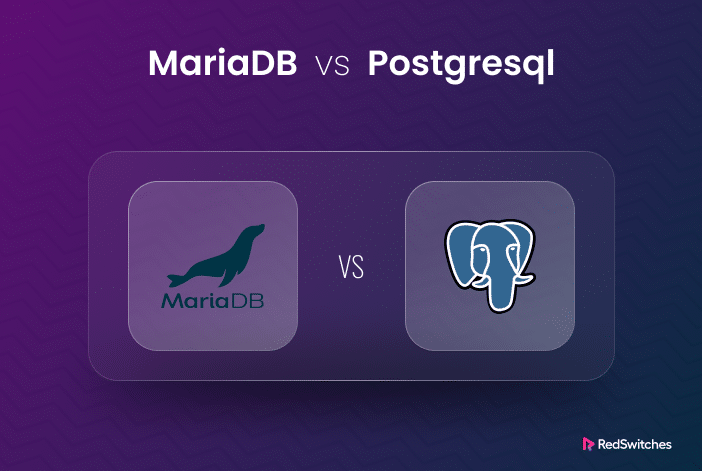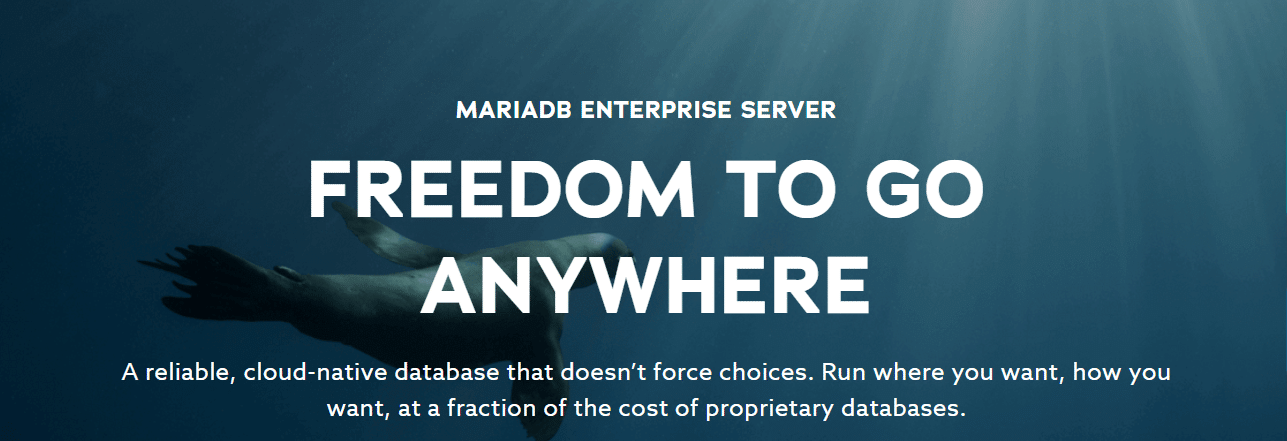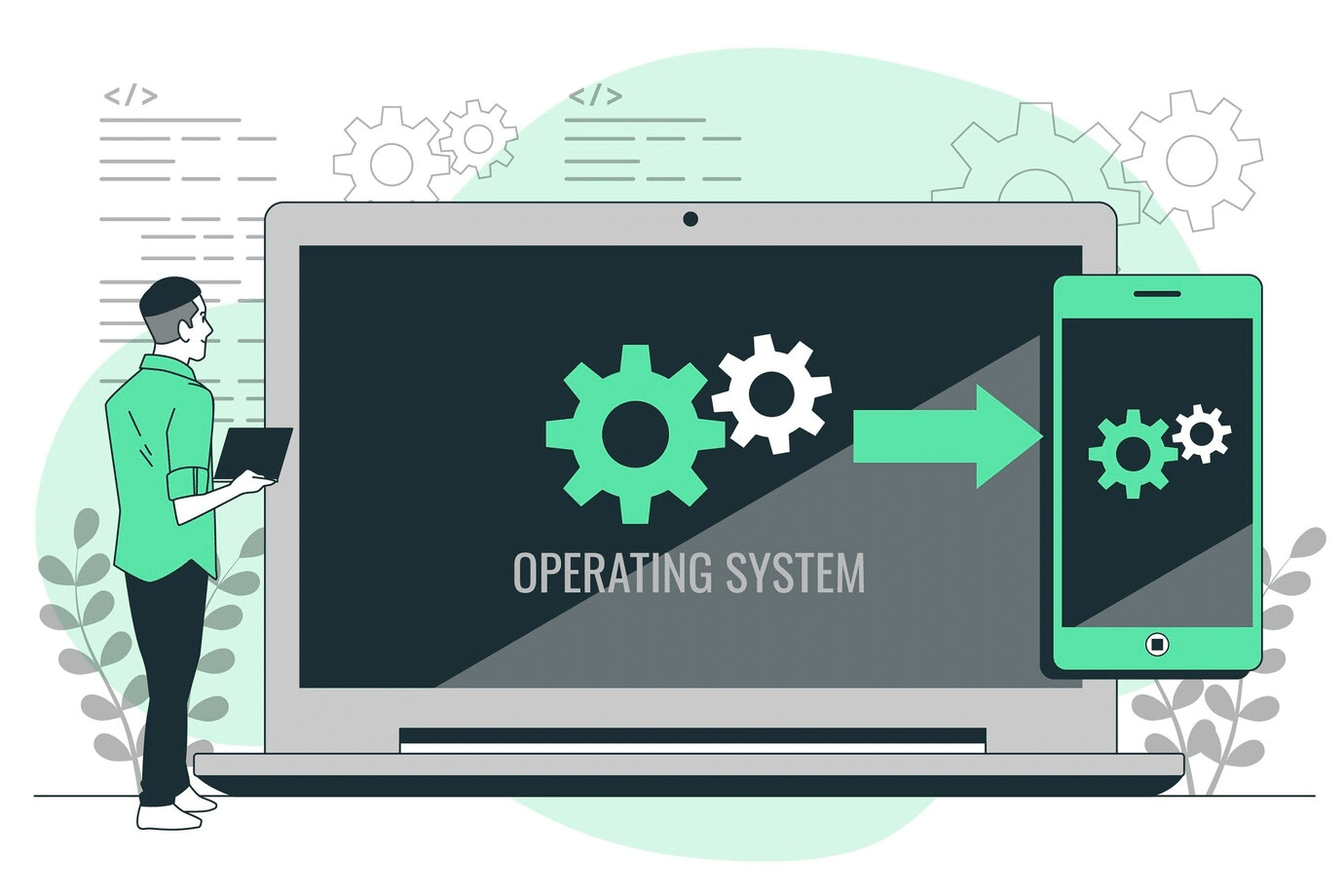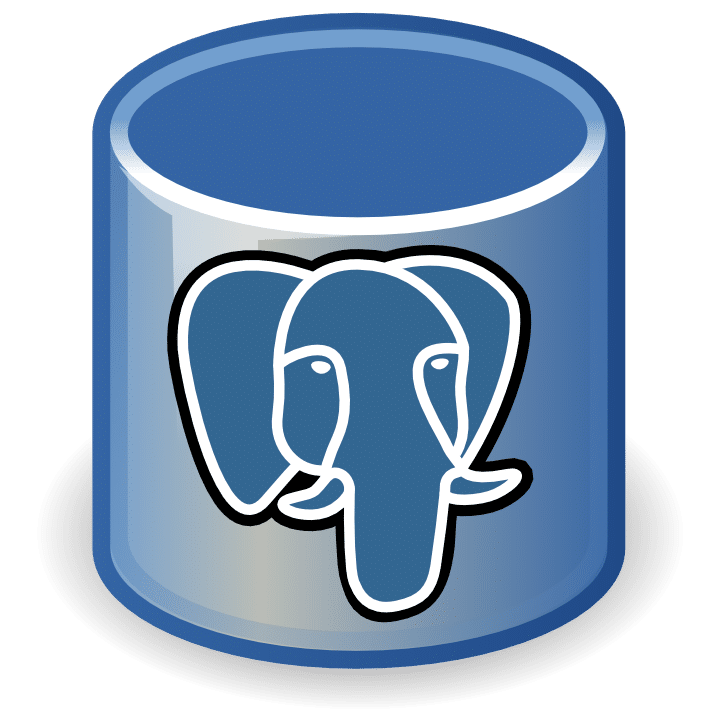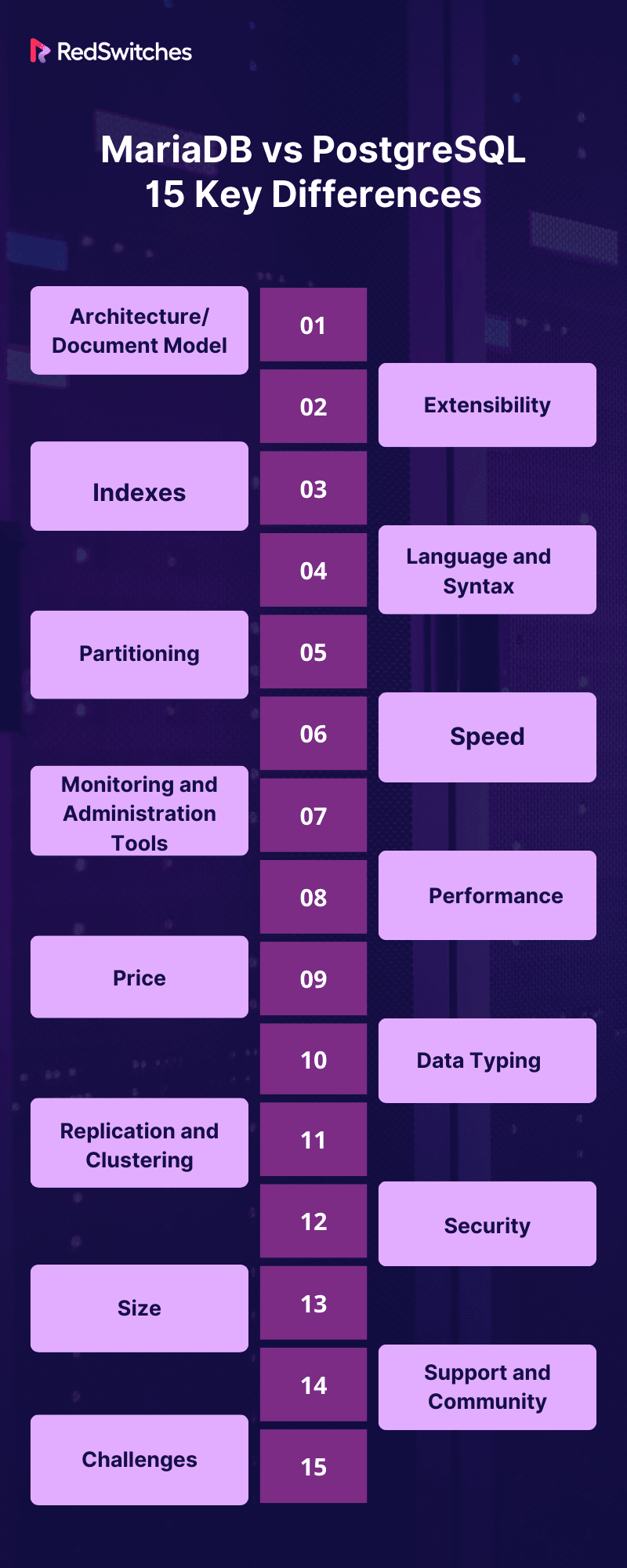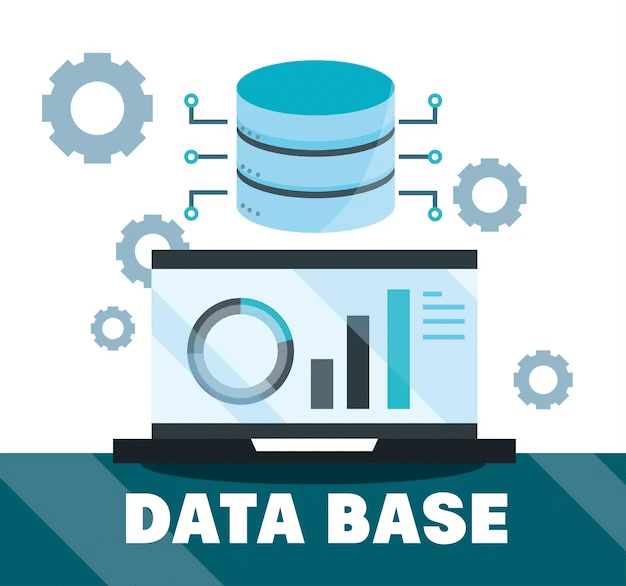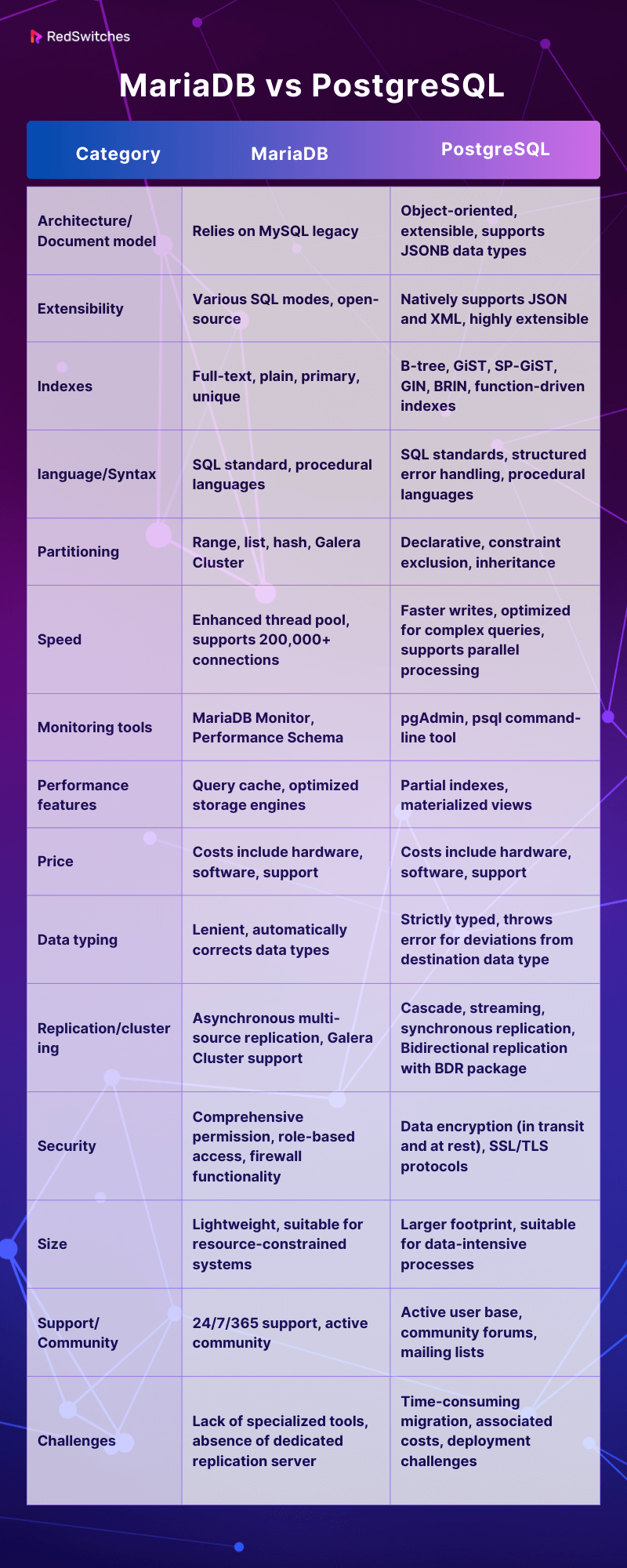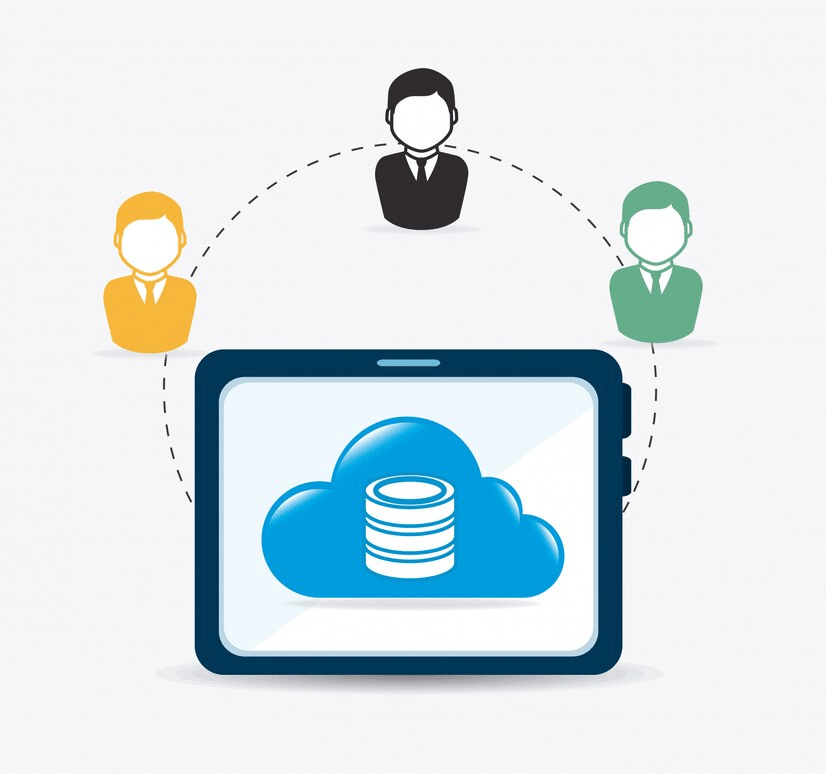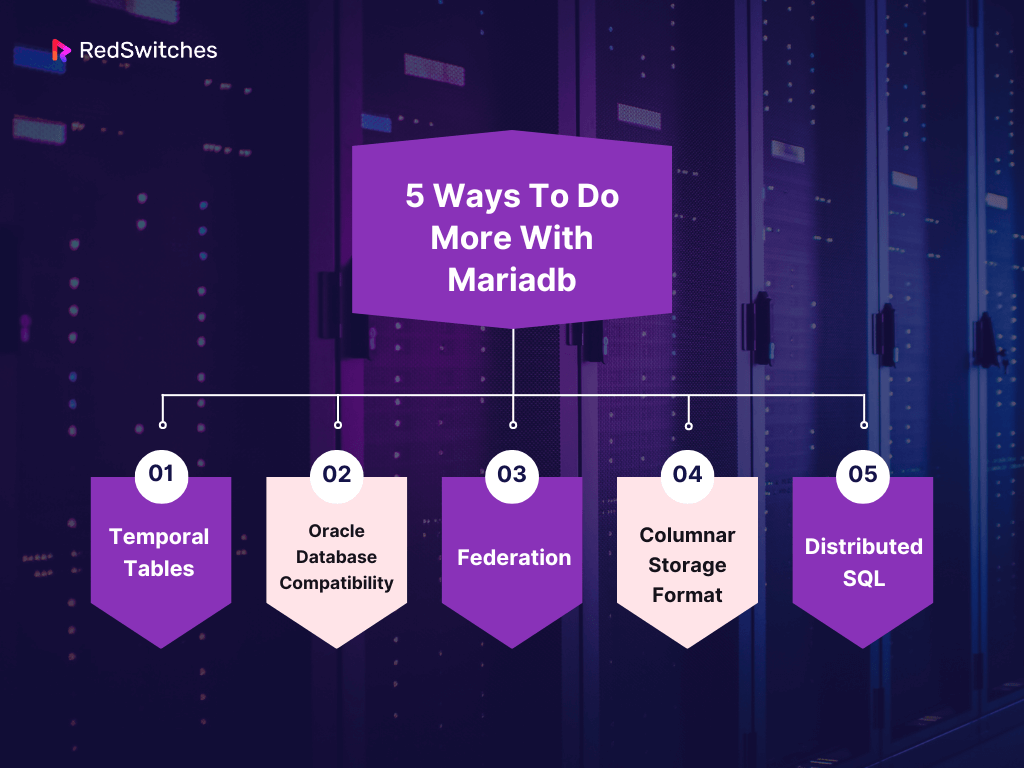Two formidable competitors in the dynamic field of database management systems—MariaDB and PostgreSQL—stand out as outstanding examples of open-source software. The choice between these two platforms frequently becomes crucial as companies and developers work through the complex web of database options. With roots in MySQL, MariaDB provides stability and familiarity, while PostgreSQL, known for its sophisticated features and extensibility, promises unmatched flexibility.
This fascinating investigation examines the merits, drawbacks, and debate of MariaDB vs PostgreSQL. Get ready for an enlightening experience that will help you make an informed decision regarding the MariaDB vs PostgreSQL debate by demystifying the complexity.
Table of Contents
- What Is MariaDB?
- What Is PostgreSQL?
- MariaDB vs PostgreSQL: 15 Key Differences
- MariaDB vs PostgreSQL: Architecture/Document Model
- MariaDB vs PostgreSQL: Extensibility
- MariaDB vs PostgreSQL: Indexes
- MariaDB vs PostgreSQL: Language and Syntax
- MariaDB vs PostgreSQL: Partitioning
- MariaDB vs PostgreSQL: Speed
- MariaDB vs PostgreSQL: Monitoring and Administration Tools
- MariaDB vs PostgreSQL: Performance
- MariaDB vs PostgreSQL: Price
- MariaDB vs PostgreSQL: Data Typing
- MariaDB vs PostgreSQL: Replication and Clustering
- MariaDB vs PostgreSQL: Security
- MariaDB vs PostgreSQL: Size
- MariaDB vs PostgreSQL: Support and Community
- MariaDB vs PostgreSQL: Challenges
- When To Use PostgreSQL Over MariaDB
- When To Use MariaDB Over PostgreSQL
- How To Migrate From MariaDB to PostgreSQL
- Step 1: Make a MariaDB database backup
- Step 2: Install PostgreSQL
- Step 3: Transfer the Backup File
- Step 4: Use PostgreSQL to Create a New Database
- Step 5: PostgreSQL Data Import
- Step 6: Update Database Connection Settings
- Step 7: Test Your Application
- Step 8: Update and Optimise Queries (Optional)
- Step 9: (Optional) PostgreSQL Database Backup
- How To Migrate From PostgreSQL to MariaDB
- Step 1: Make a PostgreSQL database backup
- Step 2: Install MariaDB
- Step 3: Transfer the Backup File
- Step 4: Use MariaDB to Create a New Database
- Step 5: Utilise MariaDB to Import Data
- Step 6: Update the Database Connection Settings
- Step 7: Test Your Application
- Step 8: Optimize and Update Queries (Optional)
- Step 9: (Optional) Backup MariaDB Database
- 5 Ways To Do More With MariaDB
- Conclusion
- FAQs
What Is MariaDB?
Credits: MariaDB
MariaDB, an open-source relational database management system (DBMS), is a suitable drop-in substitute for the widely used MySQL database technology. The developers who were instrumental in developing the original database forked MySQL to form MariaDB in 2009 in response to Oracle Corp. acquiring MySQL.
Using ACID-style data processing with assured atomicity, consistency, isolation, and durability for transactions, MariaDB is a SQL-based database. The database supports many storage engines, including InnoDB, MyRocks, Spider, Aria, TokuDB, Cassandra, MariaDB ColumnStore, JSON APIs, parallel data replication, and other capabilities.
Main Features of MariaDB
Credits: Freepik
With specific extensions, MariaDB offers the same features as MySQL. It is relatively modern and cutting-edge.
Here are MariaDB’s features:
Community-driven and Open-source
MariaDB is publicly available open-source software licensed under the GNU General Public Licence (GPL). Due to its community-driven development, users and developers worldwide can contribute to its advancement.
MySQL Compatibility
Because MariaDB is made to be highly compatible with MySQL, it may be used with existing MySQL scripts, client APIs, and applications. Thanks to this compatibility, users can easily switch from MySQL to MariaDB without having to make significant code modifications.
High-Performance
MariaDB can effectively manage massive data volumes and multiple concurrent connections since it is optimized for high performance. It combines several performance optimization strategies, such as thread pooling, query optimization, and effective indexing, to guarantee quick query execution and shorter response times.
Advanced Storage Engines
TokuDB, Aria, and InnoDB are just a few of the storage engines that MariaDB supports. The default storage engine, InnoDB, allows transactions and foreign keys in addition to offering ACID compliance (Atomicity, Consistency, Isolation, Durability). Because of this versatility, users can select the storage engine that best meets their unique needs.
Security Features
Data-at-rest encryption, SSL/TLS support for secure connections, and password validation plugins are just a few of the features that MariaDB offers since security is a top priority. Additionally, it allows role-based access control, which enables administrators to specify specific user access privileges while maintaining the security and integrity of data.
High Availability and Replication
To achieve high availability and fault tolerance, MariaDB offers high availability options like the MariaDB Galera Cluster, which uses synchronous multi-master replication. Additionally, it allows asynchronous replication, which improves data redundancy and disaster recovery capabilities by enabling data to be copied across many nodes.
Virtual and Dynamic Columns
MariaDB offers virtual and dynamic columns that let users maintain various sets of columns for various rows in the same table. Conversely, virtual columns are calculated columns that are generated in response to a query and are not physically stored. These characteristics allow for more flexibility and effective storage of various kinds of data.
Native support for JSON (JavaScript Object Notation)
Data type is a feature of MariaDB that enables users to store, index, and query JSON documents within the database. This functionality is very helpful for data interchange in contemporary web apps and APIs that use JSON data often.
Pluggable Authentication
MariaDB has pluggable authentication built in. Users can integrate many plugins and authentication mechanisms, like Kerberos, PAM (Pluggable Authentication Modules), and LDAP (Lightweight Directory Access Protocol). This adaptability improves security and permits easy integration with current authentication methods.
Triggers, Stored Procedures, and Views
MariaDB allows users to design intricate database logic and automate activities by including triggers, stored procedures, and views. Views offer virtual tables that make complicated searches easier to understand, stored procedures let you create reusable code blocks, and triggers can be configured to run automatically in response to predefined events.
MariaDB Use Cases
Credits: Freepik
Before moving on to the core topic of our blog i.e. MariaDB vs PostgreSQL, let’s throw some light on the real-life use cases of MariaDB.
Web-based programs
MariaDB is a popular choice for web applications’ backend databases. It is the best option for applications that need fast and effective data storage and retrieval due to its high-performance characteristics and capacity to manage massive volumes of data. MariaDB is frequently used for data management by online forums, e-commerce sites, and web content management systems.
Information Warehousing and Business Intelligence
Organizations use MariaDB for data warehousing and business intelligence applications. Large volumes of data may be effectively stored and managed by it, allowing businesses to perform sophisticated analytics, produce reports, and obtain an insightful understanding of their operations. MariaDB’s ability to handle sophisticated indexing and querying techniques improves the effectiveness of data analysis procedures.
Mobile Applications
Mobile apps frequently need a backend database to store user information, preferences, and app-specific data. MariaDB is an excellent option for mobile application developers due to its lightweight design and platform compatibility. It improves the user experience by ensuring smooth data synchronization and quick reaction times..
Content Management Systems (CMS)
MariaDB is essential for effectively storing and retrieving content on content-heavy websites and apps, including news portals, blogs, and media websites. CMS platforms can provide users with quick and precise search results thanks to MariaDB’s full-text indexing and searching functionality, which raises overall user satisfaction.
Online Gaming
A lot of user data, such as profiles, game statistics, and in-game purchases, are handled by online gaming platforms. MariaDB is an excellent option for online gaming databases because it manages real-time data updates and handles multiple connections at once. It guarantees fluid gameplay and keeps data integrity even under heavy loads.
E-commerce
To manage product catalogs, customer data, and transactional data, e-commerce websites need a robust and scalable database system. MariaDB’s transaction support and adherence to ACID (Atomicity, Consistency, Isolation, Durability) standards guarantee dependable and safe online transactions. Additionally, it offers data analysis tools like online analytical processing (OLAP), which aids companies in refining their sales tactics.
Financial Services
MariaDB is used by financial organizations, including banks, insurance providers, and fintech startups, to manage data securely and legally. MariaDB protects sensitive financial data’s confidentiality and integrity by supporting encryption, authentication, and audit logging. It also makes complicated financial reporting and calculations more manageable.
Internet of Things (IoT) Applications
IoT devices produce massive volumes of data, which must be instantly gathered, handled, and examined. MariaDB is a good choice for Internet of Things applications because of its capacity to store time-series data and support large numbers of concurrent connections. Through the use of IoT-generated data, it helps organizations to make more informed decisions and run their operations more efficiently.
MariaDB Pricing Model
Credits: MariaDB
There are various free plans of MariaDB available for users. Below is the list of RDBMS free versions.
MariaDB 10.2.8: MariaDB 10.2.8 is freely available under the GNU General Public Licence (GPL) and is a component of the MariaDB community edition.
MariaDB Galera Cluster: Available under the GPL for free, MariaDB Galera Cluster is also included in the MariaDB community edition. It is open-source and intended for synchronous multi-master replication.
10.0.31 MariaDB Galera Cluster: Like the previous version, this one is free to use under the GPL and is a part of the MariaDB community edition.
Connector Java 2.0.2: Connector/J 2.0.2, licensed under the GPL, is the authorized JDBC driver for MySQL/MariaDB. It is free to use and open-source.
10.0.30 MariaDB Galera Cluster: This version is publicly accessible under the GPL and is included in the MariaDB community edition, just like other versions in the Galera Cluster series.
Connector J 1.5.9: Connector/J 1.5.9 is distributed under the GPL and is open-source, just like previous Connector/J versions. This is the MySQL and MariaDB Java connection.
MariaDB 10.1.21: MariaDB 10.1.21 is a free GPL version that is part of the community edition.
MariaDB 10.2.1 Alpha: Although it is an alpha version, MariaDB 10.2.1 Alpha is freely accessible under the GPL and is a component of the MariaDB community edition.
What Is PostgreSQL?
Credits: Free images
POSTGRES, Version 4.2, created at the University of California at Berkeley Computer Science Department, is the foundation for PostgreSQL, an object-relational database management system (ORDBMS). Many ideas that POSTGRES pioneered were later available in specific commercial database systems.
An open-source offspring of this original Berkeley code is PostgreSQL.
Main Features of PostgreSQL
PostgreSQL supports various modern features that are required in an ORDBMS.
PostgreSQL Use Cases
Credits: Freepik
Let’s understand some real-life use cases of PostgreSQL.
Information Retrieval and Business Intelligence
Applications for business analytics and data warehousing frequently use PostgreSQL. Enterprises can store and analyze massive volumes of data effectively because of its extendable indexing options, support for complicated queries, and advanced analytics.
PostgreSQL can manage sophisticated analytical workloads because of features like table partitioning and parallel processing, which makes it appropriate for data warehousing scenarios.
Web-based programs
A standard option for online applications is PostgreSQL, particularly for those that need a scalable and dependable database backend. It is perfect for processing semi-structured data, frequently used in online applications because it supports JSON and JSONB data formats.
PostgreSQL is a good choice for applications involving user interactions, content management, and e-commerce because its strong transaction support guarantees data integrity.
Geospatial Applications
With its PostGIS extension, PostgreSQL offers comprehensive support for geospatial data. Because of this functionality, it is the preferred option for applications involving location-based services, mapping, and geographic information systems (GIS). PostgreSQL is used by sectors including mapping services, urban planning, and logistics to store and handle geospatial data effectively.
Scientific Research and Data Analysis
Many scientific research and data analysis initiatives make use of PostgreSQL. Researchers can store and analyze various datasets thanks to their support for complicated data types, arrays, and sophisticated indexing techniques. Because of its versatility, PostgreSQL may also incorporate custom functions and algorithms, which makes it useful for data-driven research and scientific computations.
Publishing platforms and content management systems (CMS)
Handle substantial volumes of both organized and unstructured content using PostgreSQL. It is appropriate for media websites, blogs, and digital publishing platforms because it effectively manages textual, multimedia, and user-generated material. PostgreSQL’s concurrent connection support guarantees seamless user experiences even during instances of high demand.
Fintech & Financial Services
PostgreSQL is used in the financial industry to handle risk management, transaction processing, and regulatory compliance tasks. It is a dependable option for handling financial data because it supports ACID transactions, data integrity, and security features. The extensibility of PostgreSQL enables financial organizations to tailor the database to their unique needs, guaranteeing adherence to industry norms.
Healthcare and Life Sciences
PostgreSQL stores and manages patient data, medical records, and research findings in healthcare and life sciences applications. It is appropriate for sensitive healthcare data since it supports sophisticated data structures and adheres to privacy regulations.
Drug discovery, patient care analytics, and medical research are all aided by PostgreSQL’s capacity to process massive information and execute intricate queries.
Applications for the Internet of Things (IoT)
From linked devices, IoT applications produce enormous volumes of data. PostgreSQL is an excellent option for IoT data storage and analysis because of its scalability, stability, and ability to handle time-series data.
It helps companies to gather, store, and process real-time data from Internet of Things devices, which makes predictive analytics and well-informed decision-making possible.
PostgreSQL Pricing Model
Single node and high availability clusters are the two types of database cluster plans available.
For a single node cluster with 1 Gigabyte of RAM, prices start at $15.00 per month. Single node clusters have automatic failover but are not highly available. These clusters are advised for testing and early development.
High availability clusters start at $30 per month for a primary node with 2 GB of RAM and 1 vCPU, along with at least one standby node at the same price for automatic failover.
Read-only nodes cost $15 per month at first. Read-only nodes are copies of the principal node in a cluster that are situated in different geographical areas.
MariaDB vs PostgreSQL: 15 Key Differences
We have arrived at the core part of our blog, where we will discuss and explore the MariaDB vs PostgreSQL debate considering the 15 critical points. Lets kickstart.
MariaDB vs PostgreSQL: Architecture/Document Model
Relational database management systems (RDBMS) are the fundamental database model that MariaDB and PostgreSQL use.
The document store is their secondary database model, but only MariaDB supports graph DBMS.
In a client/server architecture approach, which both MariaDB and PostgreSQL use, the server manages the database files, undertakes connections to the database from client applications, and manages the database on behalf of the clients.
The front-end application or the client typically handles database activities.
The client/server architecture server maintains the database files, answers client application connections, and conducts database activities on the client’s behalf. To carry out different database operations, the front-end application, the client, communicates with the database server. The first section will deal with the differences in the Architecture/Document Model in the MariaDB vs PostgreSQL argument.
MariaDB
Data storage and retrieval are made possible by a database system’s architecture and document model. MariaDB’s architecture prioritizes performance and dependability and is based on MySQL’s legacy. Data is effectively arranged into organized tables by its document model, which speeds up query processing.
By efficiently organizing data, the document model in MariaDB facilitates faster query processing by making searching for and retrieving particular information from the database more straightforward.
A database system’s architecture and document model makes data storage and retrieval possible. MariaDB’s architecture prioritizes performance and dependability and is based on MySQL’s legacy. Data is effectively arranged into organized tables by its document model, which speeds up query processing.
PostgreSQL
PostgreSQL has an object-oriented and extremely extensible architecture. JSONB data types are incorporated into its document format, which makes semi-structured data retrieval and storage possible. Businesses looking to match their database architecture to their application requirements must comprehend these architectural differences.
Companies thinking about PostgreSQL should be aware of these architectural distinctions, particularly concerning the document model. Due to its extensibility and support for semi-structured data, PostgreSQL is a solid option for applications whose data formats can vary over time, enabling easy adaptability to changing business requirements.
MariaDB vs PostgreSQL: Extensibility
Both PostgreSQL and MariaDB have a flexible design that allows for customization. Using shared libraries, which let developers tailor the code to their preferences, users who need specific additional functionality can implement it for their needs. However, let’s discuss how the MariaDB vs PostgreSQL debate takes place concerning Extensibility.
MariaDB
Numerous different SQL modes, partitioning, database backup and restore techniques, server monitoring, and logging are supported by MariaDB. You can design your operators, window functions, data types, functions, and anything else. Its open-source license allows for creation and customization straight from the source code.
Companies thinking about PostgreSQL should be aware of these architectural distinctions, particularly about the document model. Due to its extensibility and support for semi-structured data, PostgreSQL is a solid option for applications whose data formats can vary over time, enabling easy adaptability to changing business requirements.
PostgreSQL
PostgreSQL natively supports JSON and XML, and it is easily extensible. Therefore, you don’t need to worry about problems if you want to construct a web service and use PostgreSQL as a backend database system or employ Python map support for your business use case.
Its actions are driven by a catalog, making it so extensible. All information about the columns and tables, as well as specifics about the data types, functions, and access methods present, is retained by PostgreSQL.
PostgreSQL has an object-oriented and highly extensible architecture. JSONB data types are incorporated into its document format, which makes semi-structured data retrieval and storage possible. Businesses looking to match their database architecture to their application requirements must comprehend these architectural differences.
PostgreSQL is very extendable since a catalog guides its operations. PostgreSQL saves all details regarding the columns and tables, including information about the data types, functions, and access methods used.
The architecture of PostgreSQL is highly extendable and object-oriented. Its document format incorporates JSONB data types, enabling the retrieval and storage of semi-structured data. Companies need to understand these architectural variances to fit their database design to their application requirements.
MariaDB vs PostgreSQL: Indexes
Let us understand how indexes are different for both open-source database systems.
MariaDB
In MariaDB, there are four basic categories of indexes:
- Full-text indexes (which provide thorough text searching)
- Plain indexes (which provide non-unique but performance-boosting data access)
- Primary keys ( which guarantee uniqueness and null constraints)
- Unique indexes (which enforce uniqueness inside indexed columns).
Indexes are essential for maximizing query efficiency and accelerating the retrieval of data. MariaDB ensures quick lookups by using hash and B-tree indexes. Developers may optimize speed because its index types are customized for various use cases.
PostgreSQL
GiST, SP-Gist, GIN, and BRIN are just a few of the diverse, unique index types that PostgreSQL offers to meet any query workload effectively. Other index types include B-tree and hash. Additionally, PostgreSQL allows the simultaneous use of function-driven, partial, and covering indexes because they are non-exclusive.
PostgreSQL uses B-tree indexes and adds cutting-edge indexing techniques like GiST and SP-GiST to improve support for full-text and geometric search queries. Comprehending these various indexing strategies is essential for companies that want to create databases that provide quick and precise query outcomes, particularly for applications that require a lot of data.
PostgreSQL uses B-tree indexes and adds cutting-edge indexing techniques like GiST and SP-GiST to improve support for full-text and geometric search queries.
Comprehending these various indexing strategies is essential for companies that want to create databases that provide quick and precise query outcomes, particularly for applications that require a lot of data.
Hash indexes use hash functions to map keys quickly and are appropriate for equality-based queries. Advanced methods, such as SP-GiST (Space-Partitioned Generalised Search Tree) and GiST (Generalised Search Tree) indexes, improve support for complicated data types, such as geometric and full-text search data.
To ensure effective indexing and querying, GIN (Generalised Inverted Index) indexes are perfect for arrays, JSON, and full-text search data. Furthermore, tables are divided into blocks by BRIN (Block Range Index) indexes, which save summary data for huge databases and enhance query efficiency, particularly during scans.
MariaDB vs PostgreSQL: Language and Syntax
Both MariaDB and PostgreSQL support a wide range of SQL statements, rules, functions, and procedures in addition to a wide range of database connectors, including, but not limited to, C, C++, Perl, PHP, and Python.
Additionally, PostgreSQL supports structured error handling, if, for, and case language control structures, and common table expressions (CTE). Let’s Discuss how Language and Syntax help in MariaDB vs PostgreSQL.
MariaDB
The foundation of database interactions is the SQL language and syntax. Because MariaDB follows the SQL standard, it is compatible with many applications and reduces migration difficulties.
Its user-friendly and clear syntax makes development easier. Renowned for its sophisticated SQL support, PostgreSQL adds potent features like common table expressions and window functions.
MariaDB’s syntax is straightforward to use, which makes development easier. Because of its simple SQL syntax, database interactions are streamlined and accessible to developers with varying degrees of expertise. Because of its simplicity, development cycles are sped up, allowing engineers to concentrate on creating application logic rather than debugging intricate syntax.
PostgreSQL
It also has procedural language support, which lets programmers design intricate stored procedures and triggers. Acknowledging these linguistic nuances is crucial for companies looking to create applications with complex data processing needs.
Procedural languages are also supported by PostgreSQL, enabling programmers to create complex triggers and stored procedures. With this feature, developers may better maintain and process data more efficiently by encapsulating sophisticated business logic inside the database.
In addition, PostgreSQL allows for various linguistic control structures, including case statements, if statements, loops, and structured error handling. These building blocks enable programmers to include complex logic into database operations, improving the database’s capacity to manage challenging data processing jobs.
MariaDB vs PostgreSQL: Partitioning
Let’s have a look at how partitioning is done concerning the MariaDB vs PostgreSQL debate.
MariaDB
Along with horizontal table partitioning, MariaDB supports partitioning through sharding using the Galera Cluster/Spider storage engine. This improves the query performance of MariaDB. With MariaDB, you may additionally isolate your frequently accessible recent data from your infrequently accessed old data, resulting in faster access times.
MariaDB supports range, list, and hash partitioning, allowing developers to distribute data based on specific criteria. This enhances query performance and simplifies data management.
In today’s fast-paced digital environment, speed is crucial. MariaDB is exceptional in providing high query throughput and transaction performance. Its effective indexing and optimized storage engines provide quick data retrieval.
Furthermore, developers can horizontally divide data across several nodes thanks to MariaDB’s support for sharding, which improves scalability and permits parallel processing. MariaDB optimizes query throughput and transaction performance by separating frequently accessed recent data from less frequently accessible older data. This guarantees faster access times.
MariaDB’s high query throughput and transaction performance make it stand out in today’s fast-paced digital world. Its effective indexing methods and refined storage engines support quick data retrieval, meeting the needs of contemporary applications.
PostgreSQL
Partitioning is a useful technique. It allows you to divide a huge database table into smaller, more manageable portions. You can still treat them as components of a single logical table. PostgreSQL offers strong support for partitioning. This feature makes huge datasets easier to handle. It dramatically improves query and database maintenance work performance. In PostgreSQL, partitioning can be achieved in several ways. Each way is appropriate for a particular set of circumstances. One such technique is range partitioning. It works well with data that naturally splits into sequential chunks, such as time-series data.
Hash partitioning allocates data among partitions based on the hash value of the partition key. It offers an alternative approach. This approach guarantees equitable data distribution. It’s regardless of the distribution or inherent skewness of the key values. PostgreSQL’s partitioning feature aims to maximize query performance. It uses intelligent data organization and retrieval. It is extremely helpful when the partition key does not naturally split into ranges or lists. Partition pruning is a crucial aspect of PostgreSQL partitioning. It allows the database engine to eliminate unnecessary partitions from the query execution plan.
MariaDB vs PostgreSQL: Speed
Since the database is the foundation of your website and is regularly used by servers, the database’s speed directly correlates to the speed of your WordPress website. Your visitor count and website performance can increase with a quick website and loading times, strengthening your business even more. In this section, we will discuss MariaDB vs PostgreSQL for the speed parameter.
MariaDB
With 12 new storage engines and an enhanced thread pool that can operate quicker and support up to 200,000+ connections, MariaDB can compete directly with PostgreSQL regarding query processing speed.
PostgreSQL
PostgreSQL can provide faster writes and reads, making it the suggested option where turnaround time and speed of data access are crucial to the organization’s running. When the database needs to manage a significant amount of data, PostgreSQL is the preferred option.
PostgreSQL achieves outstanding performance, particularly in complex analytical queries, by exploiting parallel processing capabilities and powerful query optimization techniques. Businesses can customize their database systems to match individual performance requirements and provide responsive and seamless user experiences by recognizing the speed differentials.
MariaDB vs PostgreSQL: Monitoring and Administration Tools
Many tools are available for monitoring, administration, management, and troubleshooting since databases are essential software components. This section will throw some light on the MariaDB vs PostgreSQL argument with respect to Monitoring and Administration tools.
MariaDB
To meet the demands of database administrators, MariaDB provides a comprehensive suite of management and monitoring tools. The MariaDB Monitor, a web-based graphical user interface that offers real-time insights into database performance, is one of its noteworthy utilities.
It provides admins with comprehensive analytics on query execution times, server resource usage, and other critical data, allowing them to spot bottlenecks and efficiently optimize queries.
Performance tuning and troubleshooting are made more accessible by the abundance of information about server and database activity provided by MariaDB’s Performance Schema and Information Schema databases.
Regarding administration, MariaDB offers the MariaDB Server Manager, a tool made to manage several MariaDB servers effectively. This utility makes user permission management across many server instances, backup and recovery, and configuration management easier.
PostgreSQL
A wide range of monitoring and administrative tools are available in PostgreSQL, meeting the needs of various users.
PostgreSQL offers pgAdmin, a well-liked open-source administration and management tool, for administration. PgAdmin provides an easy-to-use graphical interface for managing users, configuring databases, and running SQL queries. It makes managing PostgreSQL databases easier, enabling administrators to work more productively.
Additionally, for those who prefer command-line interfaces, PostgreSQL’s psql command-line tool offers a robust interface for interactive SQL queries and database administration operations.
MariaDB vs PostgreSQL: Performance
Now, let’s discuss the performance ingredient in our MariaDB vs PostgreSQL argument. After this, you will be able to compare MariaDB vs PostgreSQL performance.
MariaDB
MariaDB is seen as being appropriate for smaller databases and can store data in memory, a feature that PostgreSQL does not have. Contrarily, PostgreSQL uses both an internal cache and the server’s page cache to extract frequently accessed data, outperforming MariaDB’s query cache.
PostgreSQL
PostgreSQL also provides many sophisticated features to enhance database efficiency, including partial indexes and materialized views. With materialized views, you can pre-calculate pricey aggregation, join operations, and store the outputs in a table within a database.
This enhances the speed of complex queries that are regularly executed and use much data to produce results.
MariaDB vs PostgreSQL: Price
MariaDB
- Self-hosted: If you are deploying MariaDB yourself, you will need to pay for the hardware and software that you use to run the database. This can include the cost of servers, storage, and operating systems.
- Managed services: MariaDB Corporation offers a managed cloud database service called MariaDB SkySQL. SkySQL is a pay-as-you-go service that includes the cost of hardware, software, and support.
PostgreSQL
- Self-hosted: If you are deploying PostgreSQL yourself, you will need to pay for the hardware and software that you use to run the database. This can include the cost of servers, storage, and operating systems.
- Managed services: There are several managed cloud database services for PostgreSQL, such as Amazon RDS for PostgreSQL, Google Cloud SQL for PostgreSQL, and Azure Database for PostgreSQL. These services offer a variety of pricing models, based on factors such as storage, compute resources, and support.
MariaDB vs PostgreSQL: Data Typing
Regarding Data typing, Maria DB is more lenient than PostgreSQL. Let’s discuss each in the MariaDB vs PostgreSQL debate.
MariaDB
In terms of data typing, PostgreSQL is less versatile than MariaDB. The data can be automatically corrected to match the destination data type, accepted, and a warning can be raised. Therefore, MariaDB is the database of choice for programs that must respond nimbly to differences in data input.
PostgreSQL
PostgreSQL is more strictly typed; therefore, it will throw an error and prevent insertion if incoming data marginally deviates from the destination data type. Data integrity is emphasized strictly in PostgreSQL.
MariaDB vs PostgreSQL: Replication and Clustering
When using delayed replication, you can specify how many seconds the replication secondary should lag the main by. This is done to ensure the secondary accurately reflects the primary’s condition at a specific point in the recent past. Let’s understand how replication and clustering parameter differs in the MariaDB vs PostgreSQL debate.
MariaDB
MariaDB supports asynchronous multi-source replication and primary-secondary replication. As a result, the MariaDB Galera Cluster supports semi-synchronous replication, multi-primary clustering, delayed replication, and parallel replication.
PostgreSQL
PostgreSQL provides cascade replication, streaming replication, and synchronous replication in addition to primary-secondary replication. Even PostgreSQL can perform bidirectional replication when using the most recent BDR package.
MariaDB vs PostgreSQL: Security
Amid the MariaDB vs PostgreSQL debate, one significant concern is security features. Let’s explore it for each.
MariaDB
MariaDB frequently publishes security updates, demonstrating the value of security to the MariaDB community.
MariaDB’s comprehensive permission and authentication features offer multiple approaches, including role-based access control and two-factor authentication, to guarantee that only authorized users can access particular database resources.
Furthermore, MariaDB provides extensive facilities for auditing and monitoring, which lets administrators keep tabs on user actions and queries, improving accountability and supporting compliance initiatives.
Administrators can mitigate potential security dangers by defining access restrictions based on IP addresses through MariaDB’s firewall functionality, which adds an extra layer of security.
PostgreSQL
The PostgreSQL Global Development Group (PGDG) offers a comprehensive list of common exposures and vulnerabilities regularly updated by a sizable and active community.
Additionally, PostgreSQL concentrates on data encryption, both in transit and at rest. It offers options for encrypting data on a disc and uses SSL/TLS protocols to safeguard data communications.
Robust authentication techniques, such as password- and certificate-based authentication, are offered by PostgreSQL to guarantee safe database system access. Like MariaDB, PostgreSQL places a strong emphasis on role-based access control, giving administrators more precise control over user permissions.
MariaDB vs PostgreSQL: Size
In this scenario, we will take into aspect the size of both MariaDB and PostgreSQL.
MariaDB
The sizes of MariaDB and PostgreSQL are very different from one another. MariaDB is a good option for applications where resource efficiency is a concern because it is lightweight and practical by design.
Because of its lower size, it can function effectively even on systems with constrained hardware resources. Due to this, MariaDB is a well-liked option for web applications, particularly those that utilize cloud-based infrastructure.
PostgreSQL
A robust, effective, and extensible open-source database system is PostgreSQL. Due to its large range of features and capabilities, it is frequently bigger than MariaDB. Large-scale applications and data-intensive processes can benefit from PostgreSQL’s robustness and dependability.
MariaDB vs PostgreSQL: Support and Community
Support and community service are very important user elements. This section will illuminate Support and Community concerning the MariaDB vs PostgreSQL debate.
MariaDB
Engineers, typically database administrators, software developers, and technical specialists in MySQL and MariaDB, support MariaDB. MariaDB Corporation offers robust 24/7/365 support to those with enterprise-level subscriptions.
Support is also accessible through the MariaDB knowledge base, where you may browse guides, instructions, documentation, and other beneficial materials.
PostgreSQL
PostgreSQL has a large and active user base that supports users via user groups, manuals, mailing lists, and additional resources. Users can also easily ask questions to knowledgeable and involved PostgreSQL community members via an IRC channel.
Additionally, there are several foreign PostgreSQL websites where you can find tools and possibilities for community interaction in your native tongue or country.
MariaDB vs PostgreSQL: Challenges
In the MariaDB vs PostgreSQL debate, both possess some significant challenges. First, we will start with Maria DB.
MariaDB
The following are some drawbacks to using MariaDB as a database for your company’s operations:
Lack of specialized tools for debugging procedures and functions: MariaDB does not offer such tools. These MariaDB processes’ reliability, especially the one for scalability database online transactions, is far from ideal.
Absence of a dedicated replication server: For users, replication would be made simpler by having a dedicated replication server. For data entered on production to be duplicated across the server, you must develop a unique approach for mirroring your database in a live environment.
PostgreSQL
When using PostgreSQL, you could encounter the following difficulties:
Time: It may take longer than expected to ensure that the PostgreSQL migration or development project is carried out without a hitch. Unexpected problems frequently necessitate further study, which might slow down development. As a result, it is crucial to include time for mobile research in the project timeline from the start.
Cost: It’s a frequent misperception that PostgreSQL is entirely free because it is open-source. While the solution is free to download, install, and use, there are virtually always expenses associated with support, migration, and maintenance, and these costs cannot be disregarded.
Deployment size: Migrating to PostgreSQL may be simple for small organizations with modest databases, but it may be more difficult for large and mid-sized businesses.
When To Use PostgreSQL Over MariaDB
Credits: Freepik
After discussing the long-lasting debate of MariaDB vs PostgreSQL, let’s learn about some scenarios where PostgreSQL might be a better choice than MariaDB:
Advanced Features Requirement: If your application requires advanced database features like materialized views and partial indexes, PostgreSQL is a better choice. Materialized views are beneficial for optimizing expensive joins and aggregations, making complex queries more efficient.
Partial Index Optimization: When dealing with datasets where not all records need indexing, PostgreSQL’s support for partial indexes shines. This is particularly useful for scenarios involving recently inserted or frequently queried data, as it reduces the overhead of maintaining and creating indexes for the entire dataset.
If your application demands advanced features and efficient handling of specific data subsets, PostgreSQL can be a superior choice over MariaDB.
Here’s a comparison table highlighting the key features:
When To Use MariaDB Over PostgreSQL
Credits: Freepik
After learning scenarios in which PostgreSQL outshines MariaDB, let’s learn about scenarios when MariaDB is preferred over PostgreSQL.
Data Type Flexibility: If your application requires more flexibility with data types during insertions and updates, MariaDB may be a better choice. MariaDB can automatically convert data to the correct type, making it suitable for situations where data consistency is not as strict.
Master-Master Replication: MariaDB’s support for master-master replication is a strong point if your application demands high availability and low latency. This feature allows for data redundancy and failover capabilities, making it ideal for critical applications where uninterrupted service is essential.
In summary, MariaDB is a good choice when you need data type flexibility and robust high availability features, which can be advantageous for specific use cases over PostgreSQL.
How To Migrate From MariaDB to PostgreSQL
After discussing the postgres vs MariaDB debate, In this blog section, we will help you understand in a step-by-step way how to mitigate data from MariaDB to PostgreSQL. Here are the steps:
Step 1: Make a MariaDB database backup
Making a backup of your MariaDB database is essential before you begin the transfer procedure. You can export your MariaDB database to a file by using the mysqldump command:
mysqldump -u username -p your_database_name > backup.sql
Step 2: Install PostgreSQL
Verify that the server where the database migration is to take place has PostgreSQL installed. Using the package manager unique to your operating system, you can install PostgreSQL.
For instance, you can use the following commands on Ubuntu:
sudo apt update
sudo apt install postgresql postgresql-contrib
Step 3: Transfer the Backup File
Transfer the backup.sql file from your MariaDB server to your PostgreSQL server in step three. You are free to utilize any preferred file transfer protocol, such as FTP or SCP.
Step 4: Use PostgreSQL to Create a New Database
To import the MariaDB data, go into your PostgreSQL server and create a new database:
psql -U postgres
When prompted, type your PostgreSQL username, which is typically postgres. Next, make a fresh database:
CREATE DATABASE new_database_name;
To give your new PostgreSQL database the name you choose, replace new_database_name.
Step 5: PostgreSQL Data Import
To import the data from the MariaDB backup file into the newly-created PostgreSQL database, use the following psql command:
psql -U postgres -d new_database_name -a -f backup.sql
Step 6: Update Database Connection Settings
Update the database connection settings to point to the new PostgreSQL database server if your application connects to the database via a configuration file. If required, change the host, port, username, password, and database name.
Step 7: Test Your Application
Once the database connection settings have been updated, make sure your application is functioning properly with the new PostgreSQL database by giving it a full test.
Step 8: Update and Optimise Queries (Optional)
There may be variations in the supported functionality and SQL syntax between MariaDB and PostgreSQL. Make sure that your database schema and SQL queries are PostgreSQL compatible by reviewing them. If necessary, optimize your queries to improve performance.
Step 9: (Optional) PostgreSQL Database Backup
Make a backup of your newly created PostgreSQL database as soon as you’ve verified that your application is compatible with PostgreSQL and that there won’t be any future data loss.
How To Migrate From PostgreSQL to MariaDB
After learning about the steps for conversion of MariaDB to PostgreSQL, in this blog article, we will do the vice versa. Let’s begin the steps.
Step 1: Make a PostgreSQL database backup
Make sure you backup your PostgreSQL database before beginning the transfer procedure. To export your PostgreSQL database to a file, use the pg_dump command:
pg_dump -U postgres -d your_database_name -f backup.sql
Step 2: Install MariaDB
Verify that the server to which you intend to transfer the database has MariaDB installed. MariaDB can be installed through the operating system’s package manager.
For instance, you can use the following commands on Ubuntu:
sudo apt update
sudo apt install mariadb-server
Step 3: Transfer the backup file
Move the backup.sql file to your MariaDB server from your PostgreSQL server. You are free to utilise any preferred file transfer protocol, such as FTP or SCP.
Step 4: Use MariaDB to Create a New Database
To import the PostgreSQL data, log in to your MariaDB server and create a new database:
mysql -u root -p
When prompted, enter your MariaDB root password:
CREATE DATABASE new_database_name;
The name you want for your new MariaDB database should be substituted for new_database_name.
Step 5: Utilise MariaDB to import data
To import the data from the PostgreSQL backup file into the MariaDB database you have established, use the mysql command:
mysql -u root -p new_database_name < backup.sql
Step 6: Update the database connection settings in step six
Update the database connection settings to point to the new MariaDB database server if your application connects to the database via a configuration file. If required, change the host, port, username, password, and database name.
Step 7: Test Your Application
Once the database connection settings have been updated, make sure your application functions properly with the new MariaDB database by giving it a full test.
Step 8: Optimize and Update Queries (Optional)
There may be variations in the supported functionality and SQL syntax between MariaDB and PostgreSQL. Make sure your database schema and SQL queries are compatible with MariaDB by reviewing them. If necessary, optimize your queries to improve performance.
To avoid data loss in the future, make a backup of your newly created MariaDB database as soon as you have verified that your application is interacting with MariaDB correctly.
5 Ways To Do More With MariaDB
Both MariaDB and PostgreSQL are multifunctional databases.
In this blog section, we will discuss 5 additional features of MariaDB that weigh it above in the MariaDB vs PostgreSQL argument.
Temporal Tables
To allow developers to query data based on a prior point in time and DBAs to audit and/or restore data after it was altered, MariaDB is the first open-source database to implement system-versioned, application-time period, and bitemporal tables.
Oracle Database Compatibility
It is feasible to “lift and shift” with MariaDB without having to change database schemas or rewrite store procedures because it is the only open-source database that is compatible with Oracle Database data types, sequences, PL/SQL stored procedures, and more.
Federation
Only MariaDB can federate heterogeneous databases, such as Oracle Database, Microsoft SQL Server, and IBM Db2, to centralize data access and/or make database transfer easier. MariaDB and MySQL can both access tables in other MariaDB/MySQL databases.
Columnar Storage Format
Columnar and row storage are both supported by MariaDB. It can be used as a data warehouse for interactive, ad hoc analytics or as an HTAP database, which stores recent data in row storage and older data in columnar format.
Distributed SQL
MariaDB can be used as a distributed SQL database for mission-critical applications that demand elasticity and complete scalability, scaling out to reach millions of transactions per second on commodity hardware while assuring high availability and enforcing strict consistency.
Conclusion
The debate between MariaDB vs PostgreSQL is seldom a one-size-fits-all one in open-source databases. We’ve examined the 15 most significant variations, offering an informed comparison highlighting each company’s distinct advantages.
Knowing when to favor MariaDB’s scalability and simple integration or PostgreSQL’s robust ACID compliance and sophisticated queries is essential. We have looked into the nuances of switching between these platforms to guarantee a smooth transition for individuals looking to transfer.
But this is not where the narrative ends. The strength of MariaDB in temporal tables, Oracle Database compatibility, federation, columnar storage, and distributed SQL are demonstrated by the extra five features we’ve announced. With these cutting-edge features, MariaDB becomes a potent solution for a range of applications.
Making a wise decision is essential in the world of databases. RedSwitches is the guiding light for individuals looking for excellent databases and dependable hosting. By bridging the gap between your database requirements and ideal performance, our expertise guarantees a seamless experience.
With knowledge of MariaDB and PostgreSQL in hand and the assistance of a hosting partner like us, your data-driven journey will be successful and easygoing.
FAQs
Q. Is MySQL better than PostgreSQL?
The choice between MySQL and PostgreSQL depends on the unique requirements. While PostgreSQL offers extensive tools for complex queries and data integrity, MySQL shines in read-intensive scenarios.
Q. Is MariaDB the best database?
MariaDB may or may not be the optimal database, depending on the project’s requirements. It’s great for scalability, usability, and community support; however, the term “best” is relative.
Q. Is MariaDB compatible with PostgreSQL?
Despite having identical syntax, advanced features and optimizations in MariaDB and PostgreSQL make them incompatible.
Q. MongoDB vs MariaDB: Which is better?
While MariaDB is a relational database that works well for structured data, MongoDB is a NoSQL database that is appropriate for unstructured data. The decision is based on the project’s scalability requirements and data model.
Q. What is better than PostgreSQL?
There isn’t a solution that works for everyone. Depending on the requirements, PostgreSQL may not be a better choice than databases like MySQL, MariaDB, Oracle, or SQL Server.
Q. What are the main differences between MariaDB and PostgreSQL?
MariaDB is a drop-in replacement for MySQL, offering better performance and additional features, while PostgreSQL is a powerful, open-source, object-relational database system known for its robustness and extensibility.
Q. Which database solution is best suited for a web application – MariaDB or PostgreSQL?
Both MariaDB and PostgreSQL are capable of efficiently handling web application data. The choice between the two depends on specific project requirements, such as transaction complexity, scalability needs, and developer familiarity with SQL syntax.
Q. When should I use MariaDB instead of MySQL?
MariaDB is a suitable choice for a MySQL replacement with improved performance, enhanced functionality, and support for additional storage engines and plugins, making it a better fit for specific database needs and applications.
Q. What are the key advantages of using PostgreSQL over MariaDB?
PostgreSQL offers advanced features such as support for complex data types, full-text search, and JSONB data storage, making it a preferred choice for applications requiring extensive data analysis, geographical information system (GIS) support, and sophisticated querying capabilities.
Q. Can PostgreSQL be used as a replacement for MySQL?
PostgreSQL can serve as a viable alternative to MySQL for different types of applications, providing a robust and scalable relational database system with features like table inheritance, role-based access control, and native data types.
